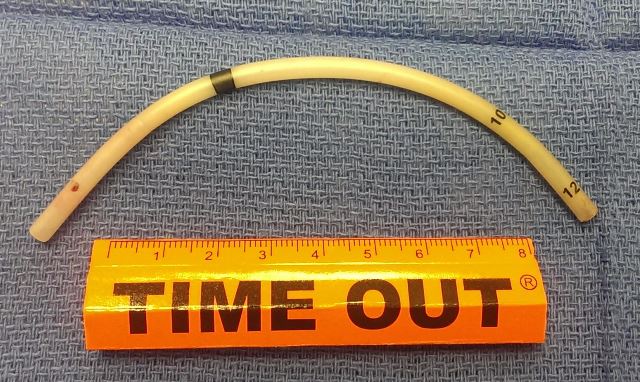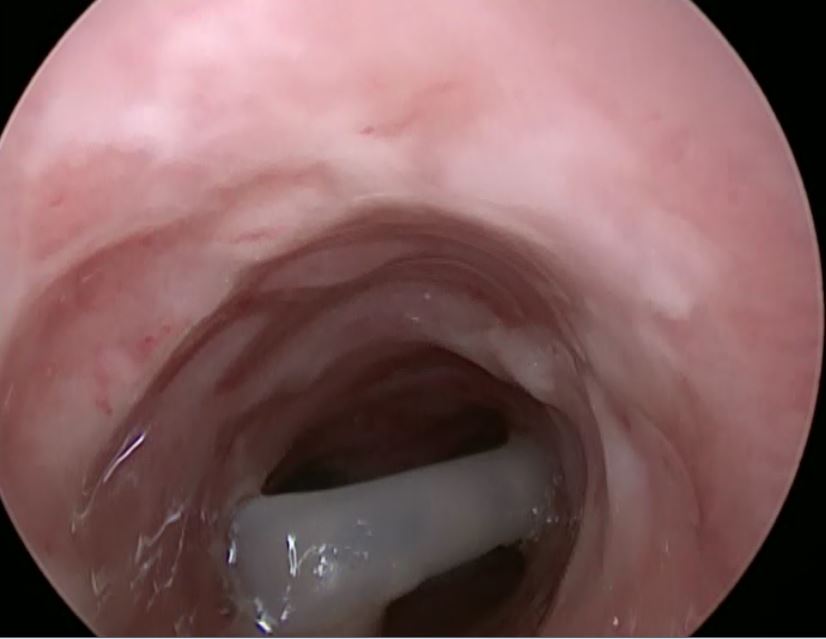AIR-16
Unexpected iatrogenic tracheobronchial foreign body presenting as intraoperative airway obstruction: retained closed circuit suction catheter in a Prader-Willi patient
Thoeny A, Le S
Children's Hospital Los Angeles, Keck School of Medicine of USC, Los Angeles, California, USA
Background: Tracheobronchial foreign body (TFB) is one of the most common pediatric airway emergencies; delayed diagnosis can lead to long term complications such as recurrent pneumonia, bronchiectasis requiring lobectomy, or even death1,2. We present a case of TFB from a broken tip of a closed catheter suction system (CCSS) that was retained in our patient for 6 days until discovered by the anesthesiology team intraoperatively.
Case Report: An 18-year-old boy with Prader-Willi Syndrome, DM 2, and severe kyphoscoliosis (>100° thoracic curve and >80° kyphotic) was scheduled for posterior spinal fusion (PSF) T3-L3.
On the day of surgery, patient underwent an uneventful IV induction and was intubated with GlideScope and bougie after 2 failed DL attempts. Approximately 3 hours into the case, loss of MEP and SSEP signals necessitated a temporary rod and quick closure. Patient was then transferred to PICU intubated. Next day prior to extubation, CXR was significant for a catheter “projecting over RUQ which may represent the patient’s epidural catheterâ€. On the floor, he had persistent episodes of coughing, tachypnea and shallow breathing; oxygen saturation remained 98-100% on room air.
On hospital day 7, patient returned to the OR for the 2nd stage PSF. Shortly after turning prone, he developed a significant decrease in pulmonary compliance that was transiently relieved with aggressive ETT suctioning and albuterol. Flexible fiberoptic bronchoscopy revealed a TFB at the level of the carina (Image 1). Decision was made to return supine and consult otolaryngology for immediate TFB removal. A 12-cm catheter tip of a CCSS (Image 2) was retrieved after 30 minutes of difficult rigid bronchoscopy. He underwent the rest of surgery without complication, with disposition to PICU intubated. He was eventually discharged home after a month in rehab for severe oropharyngeal dysphagia.
Discussion: This is the only case report of CCSS malfunction causing dislodgment within the airway as a TFB. The patient did exhibit signs of respiratory distress that could be explained by a retained TFB, but his complex medical history made elimination of more common differential diagnoses such as atelectasis or splinting due to acute postoperative pain challenging. This case highlights the importance of inter-disciplinary communication and astute management of postoperative complications when caring for a complex surgical patient.
References:
1. Kaur et al. Foreign body blocking closed circuit suction catheter. Int J Appl Basic Med Res, 2014, 4(1): 50-2.
2. Karakoc et al. Foreign body aspiration: what is the outcome? Ped Pulm, 2002, 34: 30-6.
Top













